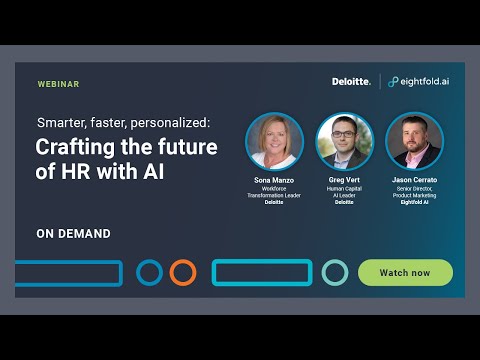Filters
Why Audiovisual Pioneer Dolby is Investing in Its Contingent Workforce
To meet the pressing demands of today’s quickly shifting market, talent leaders need complete visibility into their total workforces. And that includes contingent workers.
By incorporating contingent workers into a comprehensive talent strategy, organizations can create a balanced workforce that meets immediate skill needs more effectively, making them more flexible and adaptable to change.
Alan Kumar, Dolby’s Elastic Talent Program Manager, talked to Eightfold about the company’s integration of full-time and part-time talent strategies. The goal is to grow a more robust contingent workforce and gain a more comprehensive view of skills, giving Dolby the flexibility they need to build a more resilient workforce.
“Gone are the days of working for a company for 30 years and staffing up a bunch of folks,” Kumar said. “Instead, we use AI, automation, and candidate-relationship management to build talent pools that we can re-leverage. It’s a fundamental shift from the traditional.”
When it came time for the audiovisual pioneer to adopt a truly elastic talent strategy that can quickly scale up and down, Kumar said Dolby chose to extend its existing AI platform to include contingent workers with Eightfold Talent Flex.
Here’s why Dolby decided to invest in their contingent workforce.
See how AI-powered talent intelligence helps talent leaders get a complete view of their contingent workforce’s skills and capabilities.
Contingent Workers Can Be Strong Supporters of the Brand
Talent professionals know they must provide high-quality touchpoints throughout a person’s experience with their organization. With projections that more than 50 percent of the U.S. workforce will be freelancers by 2027, extending positive experiences to this essential group of workers is increasingly important to strengthen your talent pool and build positive associations with your brand.
Poor candidate experiences during the hiring process can easily sway candidates from working for your organization. In a 2020 CandE report, more than half of candidates said they shared negative experiences with others in their network.
The good news is that great application and interview experiences can create brand loyalty and positive feedback loops that impact future talent pipelines. “Inadvertently, people will talk to each other more,” Kumar said. “It’s going to create talent pools, and we can tap into people we have worked with before.”
When organizations don’t leverage their brands, nurture talent pools, and re-engage with former candidates, they miss out on opportunities to hire for critical skills — especially with contingent talent. “Maybe this person doesn’t want to be full-time, but we don’t have to lose them,” Kumar said.
With AI-powered talent intelligence, organizations can keep every candidate — whether they ended up working for you or not — in the loop. This strengthens your talent pool and maintains stronger connections between people who interview with you and your brand. If they had a great experience the first time, they’d be more likely to talk to you again.

Think Elastic for the Long-term Win
More than 80 percent of large corporations plan to increase their flexible workforces in the coming years, according to a report by Intuit.
No organization is immune to ups and downs in the economy and its impact on staffing needs. Collectively, we experienced this with pandemic downsizing and subsequent hiring challenges of the Great Resignation. What comes next is anyone’s guess, but one thing is clear — there is a greater need for flexibility.
“Look at the economy today,” Kumar said. “We don’t know where we’re going with this. We need the utmost flexibility. So how do we lever up and down as needed and always come back to what is core to Dolby and where we should go next?”
Kumar says it’s about finding the right approach to hiring contingent workers based on their skills and experiences. Rather than scale up or down arbitrarily, leaders need data to make informed decisions about talent at scale, regardless of a person’s employment status.
Related: Read more about why rethinking your contingent workforce is essential to your talent strategy.
A Talent Pool With Untapped Potential
Contingent workers can offer more value to an organization beyond short-term or project-based work. This is because they bring their accumulated knowledge and skills with them.
“It’s about developing the relationship, not just hiring them for that need,” Kumar said. “We need to shift from treating people like dollars to treating people like people.”
Filling a short-term business need by hiring qualified contingent workers is just one part of the equation. Hiring those gig workers based on their skills and applying an informed viewpoint into how those skills can permeate the business — and be rehired again and again — unlocks a treasure trove of potential.
In most cases, organizations find the skills they need from various talent sources — contingent workers are a big part of that. “HR should be integrated,” Kumar said. “You’d be foolish not to at least look at different tools to try and tinker with things and see how you can re-engineer your processes.”
With a skills-based total talent strategy incorporating contingent workers, Dolby now has a clear view of its talent strengths and gaps — and the intel they need to make better-informed decisions about talent strategies that align with business objectives.
For more insights on building an elastic workforce program, watch the full conversation from HR Technology Conference 2022, featuring contingent workforce experts from Dolby and Eightfold AI.
The post Why Audiovisual Pioneer Dolby is Investing in Its Contingent Workforce appeared first on Eightfold.

